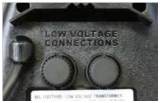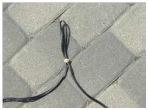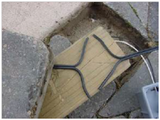________________________________________________________________
Kerr Lighting is the original designer and manufacturer of low voltage landscape lighting products and perfect for lighting up your driveway. For over 25 years Kerr Lighting has been developing unique and innovative products designed for the interlocking paving industry as well as private homeowners. Kerr Lighting products are manufactured in North America. Located in St. Charles Illinois. Kerr Lighting products are available worldwide.
Yes you can, provided the total wattage of the landscaping lights on the low voltage cable run does not exceed the total wattage of the transformer. For example, if your project includes 10 cobble or paver landscape lights on a cable run, each with a 7 watt bulb, the transformer must have at least 70 watts of power (10 lights x 7 watts each)
Absolutely. As with all low voltage systems, make sure the transformer can accommodate the total wattage of the lights connected to it.
Paver Lights are made from high-strength polymer plastics and are engineered to withstand the weight and pressure of light vehicular (cars and light trucks) loads. The perfect solution for driveway lighting.
The paver lights at the end of the cable run seem to be dimmer than those at the front. What’s happening?Lights closest to the transformer will receive more power than those further down the line. If a cable run is too long or if too many lights are being powered by a single transformer, noticeable voltage drop may occur. Voltage drop causes the lights farthest from the transformer to become dim.
Voltage drop can be minimized by:
If you have concrete or clay brick pavers that are not set in mortar, it’s easy to install Paver Lights. Most times it’s simply a matter picking up the border pavers, installing the power cable underneath, and then reinstating the pavers and lights.
T-5 Wedge Based bulbs in 4 or 7 watt clear varieties sold in packages of ten are available through this online store under Replacement Parts and Accessories. Low voltage bulbs are readily available at most retail home centers, hardware stores and other retail locations.
We do not make a solar powered paver lights. Solar Lights need lots of direct sunlight to power them, and most areas of the country do not receive enough consistent sun to keep them burning bright and illuminated long enough. solar powered lights need to be in direct sunlight to charge the batteries. As an alterantive, Kerr lights require little electricity and can be placed anywhere, even in completely shaded areas.
LED lights are more expensive than low voltage lights. They also emit a relatively low amount of light at a relatively small angle range, while low voltage light bulbs illuminate in all directions and give out much more brightness of light. LED’s are also very sensitive to extreme temperatures (both hot and cold) and may not operate properly in these conditions.
When installing paver lights in areas where there may be snow, make sure that the fixtures do not protrude above the surface so they don’t get caught by the edge of a shovel or plow. The lights themselves give off enough heat to melt any snow or ice that may accumulate.
When using Kerr Paver Lights in a new installation, light lenses can be scratched by plate compactors if not protected. Please cover the lens with cardboard or a similar protective material to ensure that it does not become damaged during compaction.
Do not apply paver cleaners or sealers to the light lens to prevent discoloration.
No. The low voltage cable can be buried directly in soil, sand, or stone.
The clips are inserted into the holes in the bottom of the Paver Light so that the pavers on either side will hold it in place.
Yes you can, but we recommend using the 4 x 8 brick shape only. You’ll have to notch the concrete to accommodate the fixture. Make sure there is free-draining stone under the light or drill holes in any concrete that may remain.
1. Draft a layout of your project showing the location where the transformer will be plugged in and the desired location of your lights. Lights are typically placed 5 - 8 feet apart for good lighting distribution, but you may prefer otherwise.

2. Make sure you have the materials and tools needed to complete your installation. You'll need:

3. Split one end of the power supply cable and remove about 3/8" of the insulation on each side to expose the copper wire inside. Connect each side to the knobs on the back of the transformer.
4. Mount the transformer indoors or outdoors near a plug. Transformers placed near swimming pools or other water sources should be plugged into a GRCI-protected outlet and the control unit should be mounted at least 10 feet from the edge of the water. Do not pug in the transformer until all lights have been installed.
5. All Kerr Paver Lights come pre-assembled with the bulbs in the sockets which are attached to the base.

6. Run the low voltage cable which will supply power to the lights around the perimeter of your project. For installation with segmental pavers, you may set the cable atop the bedding sand under the border course of pavers to keep it from being damaged when digging in the yard so it can be easily located. For a loop in the cable where the lights will be located (with a rubber band if desired) leave enough slack for the connection of the light to the power cable.

7. When using the silicone connectors cut the power supply cable in half where the lights will be located and split it down the middle. Not that one side of the cable is ribbed and one is smooth. Do not strip the insulation from the cable. See back of sheet when using the brown connectors.

8. Wires will be rejoined and lights attached using the connectors. Examine the connectors and note that there are three holes in each. Take the ribbed side of one end of the split power supply cable and push it into one of the side holes in the connector. Push it in until it goes all the way to the back of the connector. Take the ribbed side of the other end of the split power cable and place it in the hole on the other side, again making sure that it is pushed all the way back, Finally take one of the wires from a light and place it in the center hole, pushing it to the back of the connector. The connector should have 3 wires in it.

9. Once you have all three wires in each of the three holes and pushed all the way to the back, squeeze the connector with a pair of pliers to push the back cap down. This will make the connection between all three wires and will require some force. The connectors also contain silicone to protect the connection from moisture which may squeeze out at this step; be careful not to get it on your clothing.

10. Repeat steps 8 and 9 using the smooth sides of the power supply cable and the other wire from the light. You should end up with two connectors per light as shown. After all lights have been attached, plugin and switch on the transformer to test all the connections.
11. Connectors should be buried below the pavers in the sand setting bed, in the ground, or in the stone behind retaining and garden walls.
12. Set the light fixture in its place, Make sure adjacent pavers sit on the "L" shaped feet that come with some paver Lights or on the extended bottom plate that is part of the light base on others to hold down the light. Run the wiring under or around the existing or new pavers.
13. Install the light lens.
When you reach the last light on the string, you will only use two holes on each connector as shown.
Installation using brown saddle connectors included with some light kits
Split the power supply down the middle without exposing the internal copper wire. Do not cut the cable in half.
Straddle one side of the split power supply cable with the connector and insert one of the wires from a light (either white or back) in the other hole in the connector as shown. Then crimp the connector with pliers and repeat the process for the other half of the low voltage cable. You should have two connectors per light.
3925 Stern Avenue
St. Charles, IL 60174
(800)932-3343
www.sek.us.com
Kerr Light Kits include transformers which are sized to accommodate the number of lights included in the kit. Should you decide to add lights to the kit, and when planning your project, the wattage of the transformer must exceed the total wattage of the lights on the power cable, For example, of your project includes 10 lights on a string, each with a 7 watt bulb, the transformer must exceed 70 watts of power (10 lights x 7 watts each). The closer your lamps are placed to the transformer, the higher their voltage (and wattage) readings will be. Those farthest away will have lower voltages. If a cable run is too long or if too many lights are being powered by a single transformer, noticeable voltage drop may occur. Voltage drop causes the lights farther from the transformer to become dim. Voltage drop can be minimized by:
When using Kerr Paver Lights in a new installation, light lenses can be scratched by plate compactors if not protected. Please cover the lens with cardboard or similar protective material to ensure that it does not become damaged during compaction. To prevent lens discoloration do not apply paver cleaners or sealers to the light lens. Accessory and replacement parts, including lenses and colored bulbs, are available.
Paver Light Bob offers all Kerr Lighting Replacement Parts through this online store.
When a paver light goes out due to bulb exhaustion or accidental breakage, you can replace the paver light fixture or just the bulb itself by following these directions.
There can be several possible causes of a paver light stoppage.
Carefully dig out the paver light and examine it to check if the top is broken.